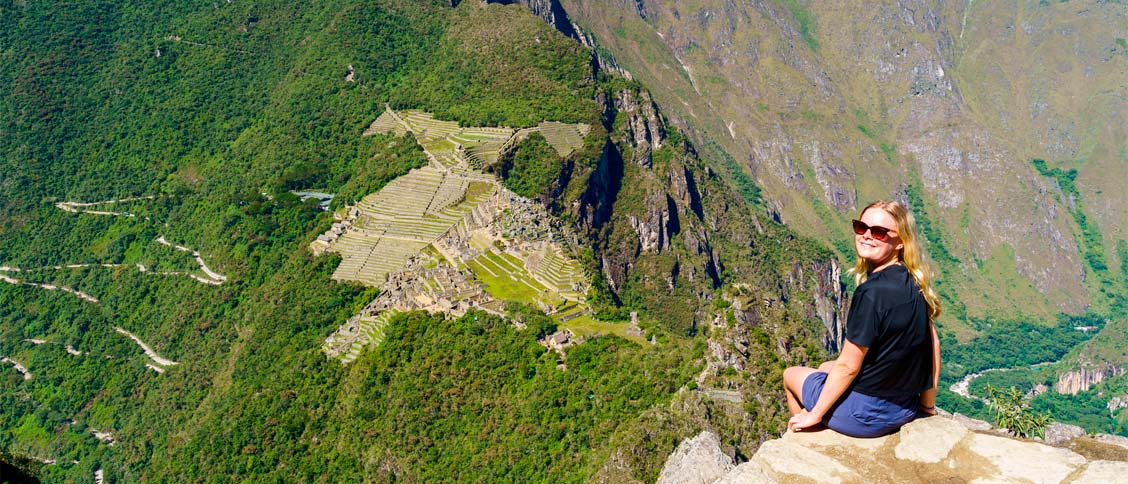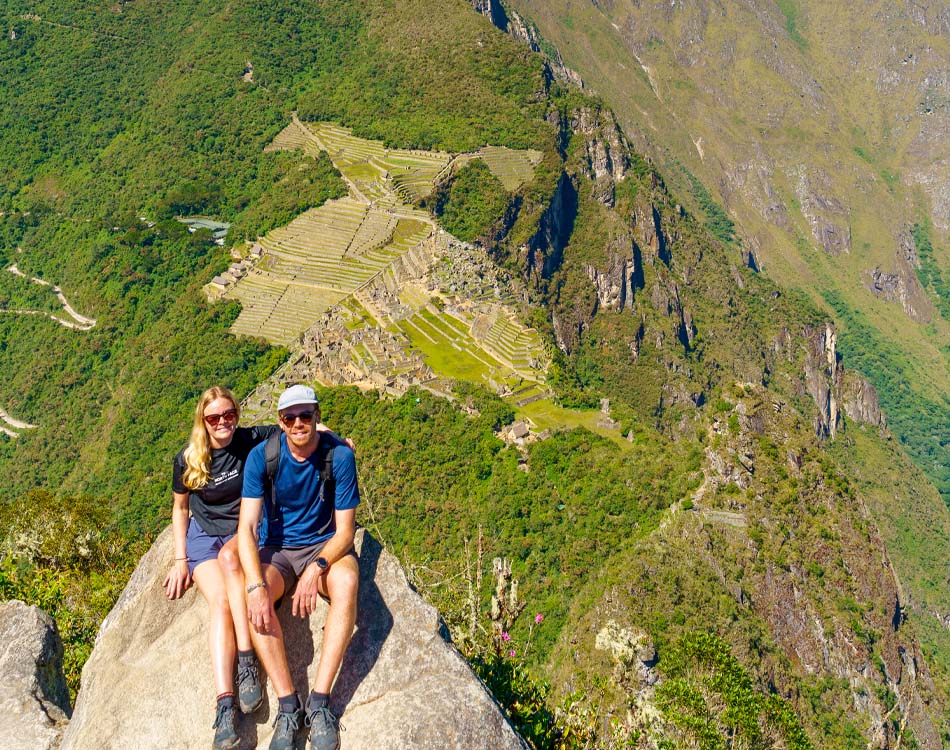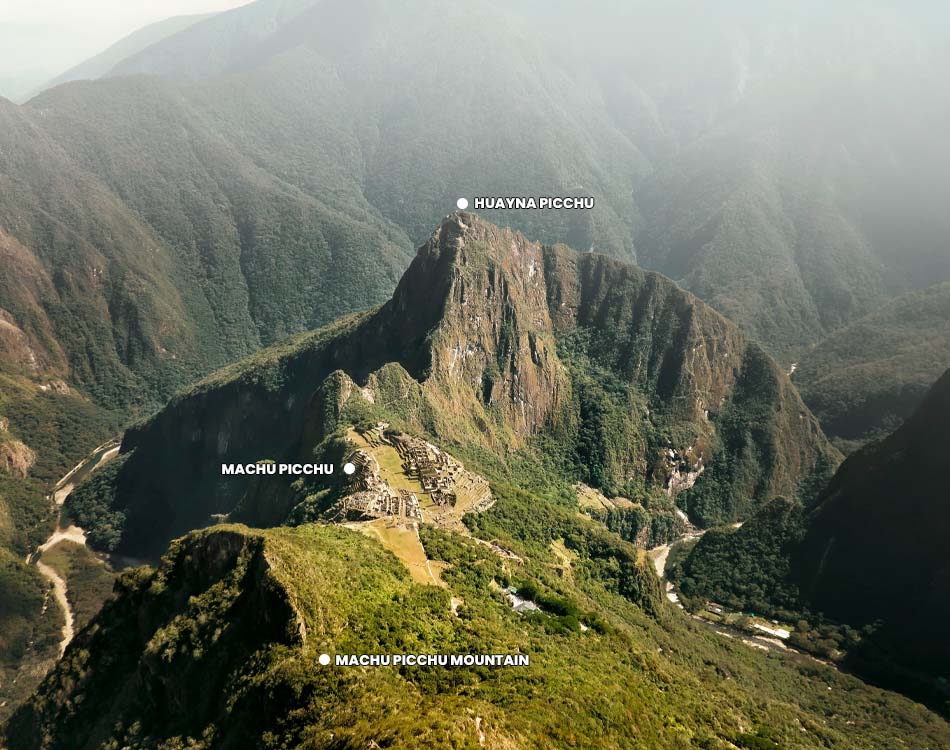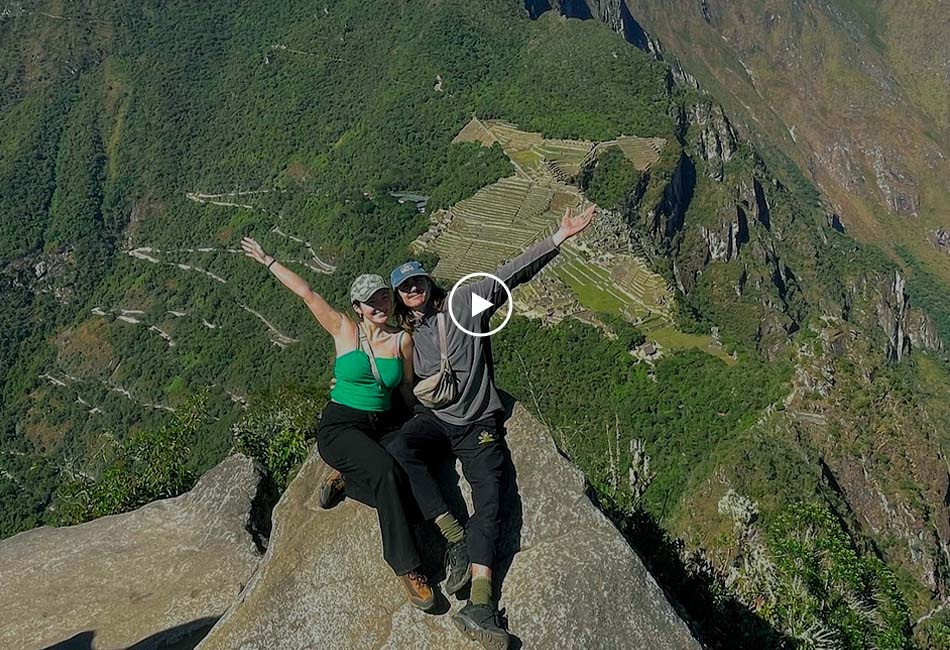
Huayna Picchu, which means “Young Peak” in Quechua is one of the characteristic views of Machu Picchu – known to many because of its famous steep climb up the “Stairs of Death”. Also known as Wayna Picchu (pronounced the same way), Huayna Picchu is one of the two mountains located next to the citadel of Machu Picchu. For this reason, it is a must visit for both hikers and thrill seekers who wish to add an exciting and memorable adventure to their stay at Machu Picchu. Read on to learn everything you need to know about hiking on this famous peak.
Among the most impressive hiking trails in Machu Picchu, there are a few in the vicinity of Machu Picchu that are really fantastic, like the Huayna Picchu Mountain hike. This imposing mountain can be seen behind all the famous photos and postcards pictures of the Inca citadel. The advantage of climbing it is the impressive panoramic views of Machu Picchu that you will have from another angle view point. Also, this famous hiking trail is usually done by hundreds of tourists daily. And for this reason, together with our Orange Nation Peru parthner, we have decided to prepare a complete article about this quaint mountain. In this way, you will know in depth what awaits you when you undertake this imposing route among other Machu Picchu tours.

Before starting, the most important thing is that you have to buy Machu Picchu tickets in advance (as much in advance as possible) because they will be sold out. The Peruvian government limits the number of people who can visit Machu Picchu each year and this also applies to hikes within Machu Picchu, both in Huayna Picchu and in the Machu Picchu mountain.
The limit for the Huayna Picchu hike is 400 people per day and is divided into four entry times:
Entry times to Machu Picchu and Huayna Picchu
| Group | Machu Picchu Entrance Time | Huayna Picchu Entrance Time |
| #1 | After 6:00 am | 7:00 am – 8:00 am |
| #2 | After 7:00 am | 7:00 am – 8:00 am |
| #3 | After 8:00 am | 10:00 am – 11:00 am |

When is the best time to go on an excursion to Huayna Picchu Mt? The short answer is between June and September. These months are considered the dry season in Peru, so you are less likely to encounter rain and storms. However, if you want to beat the crowds, traveling between December and March will bring fewer tourists. To simplify your decision, the table below offers all the pros and cons of each season so you can decide what is best for you:
| Season | Pros | Cons |
| Rainy Season(Dec-Mar) | More misty and magicalLess tourists in Machu Picchu | Expect rainSame amount of hikers on Huayna PicchuTickets still sell out quickly, but not as fast |
| Dry Season(Jun-Sep) | Rain less likely (you are still near the rainforest)Warmer and drier | Busy with touristsTickets sell out way in advanceSame amount of hikers hike HP in both seasons |
During the intervening months, the season is in transition, so most of the time you will see both rain and sunshine during the day.

Now that you know about the tickets, how to get there, when to go and what to pack, you might wonder, what is the walk really like? This step-by-step guide takes you through every part of the way:
The walk begins at the checkpoint next to the Sacred Rock on the far side of the citadel of Machu Picchu. At the assigned time, the ticket is presented and signed before starting the walk. It starts relatively flat, but quickly changes to windy climbs and descents through rocky terrain and beautiful green landscape.
As you move up the mountain, the walk becomes a steep turn. You are most likely walking with or near other groups, so be sure to be polite on the way and let people go ahead of you if you want to pass, or politely ask to pass if you are prepared to go ahead. Once you have passed through the setbacks, you will have reached the infamous stairs.
These “Stairs of Death” or “Escaleras de la Muerte” of Huayna Picchu deserve their own section because of their great architectural magnificence (and their terrifying reputation). These steep steps are original stairs built by the Incas dating back to 1400. However, don’t let that deter you. The Incas were masters of their craft and created architectural wonders with better structural integrity than many modern buildings.
Looking up can be intimidating, but looking down is worse, so keep your eyes on the prize. And be sure to use the handrails and ropes to keep going. If you feel dizzy or need a quick rest, just step aside on one of the terraces where you can take a break on flat ground.
If you are still wondering, is Huayna Picchu Mt dangerous? The answer is NOT. Not only are guides posted on the trail to help you, but there are also rails, ropes and other people around you to keep you safe.
At this point you have managed to cross the difficult section and land at the top where the ruins begin to appear around you. This is a great time to explore the surroundings and take your first pictures. It is also the time when you have to choose: continue on the main trail or take the side trail to the Temple of the Moon. The second option adds 45 minutes more in total, but it is worth seeing. This 1,500 year old temple built inside caves is a mystery to today’s historians, but it was possibly used for rituals, sacrifices or moon worship. To reach this area, you must follow the side road that goes down and around the back of the mountain and finally goes back up the main road that leads back to the entrance.
If you decide to stay on the main trail, you can enjoy the views from the “Throne of the Inca” overlooking Machu Picchu. This rocky formation is a perfect place to take pictures and contemplate the beauty of the area. You will see spectacular views of the mountain tops, the ruins and the winding river below. But don’t delay too much, the rest of the hikers will arrive behind you and can only go in one direction. You have to keep moving to avoid a traffic jam. From the viewpoint, go down the stairs and under the “Throne” to start the descent.
Similar stairs that took you up will take you down the mountain back to the checkpoint. Pass by carefully to ensure your safety and take your time, don’t rush. This is also a good opportunity to see the last views before you leave the walk. When you arrive at the entrance of Huayna Picchu, signal the exit and make your way to the exit of Machu Picchu where you can rest, eat and rehydrate.
Huayna Picchu Mountain may be the most popular option, but if you are looking for a little more difficulty, then the Machu Picchu mountain hike is your best option. Located at the opposite end of the citadel of Machu Picchu, this hike takes approximately 4 hours round trip and is at 3,050 meters above sea level. In comparison, it is about 330 m higher than Huayna Picchu, so you will definitely like the exercise. Although there are no death stairs, this hike is still steep and has no ruins at the top. However, it has an almost 360º view of the mountains, Machu Picchu and the river. It is a worthy competitor to the beloved Huayna Picchu hike, so be sure to consider it before buying tickets.
Yes, we couldn’t recommend the Huayna Picchu trek any more. The terrain may be rugged, but the view of Huayna Picchu is unforgettable. This hike takes your visit to Machu Picchu to the next level, both figuratively and literally! Start planning your next adventure today and connect with one of our travel consultants.
You’re probably wondering how to start dealing with this. Fortunately, there are four easy ways to prepare for success when traveling to high altitude areas and the elevation of Huayna Picchu Mountain.
What should you bring? As the weather in Machu Picchu can be somewhat unpredictable, we have made a list of safe things to do to make your hike in the Huayna Picchu mountain unforgettable: